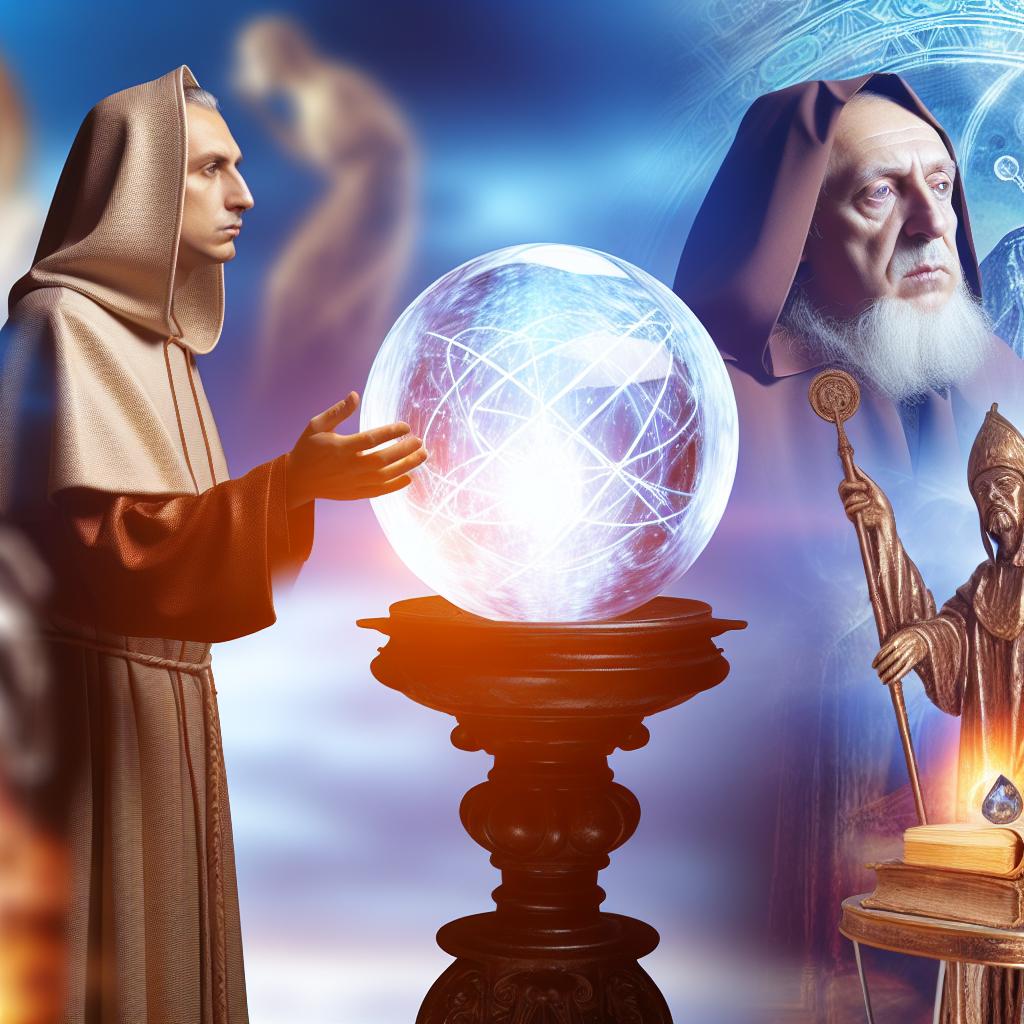
John Dee
John Dee remains a notable figure in the realms of mathematics, astronomy, and the esoteric arts, particularly regarding his complex relationship with mysticism. Serving as an advisor to Queen Elizabeth I, Dee’s intellectual pursuits were not just limited to known sciences of the time. His intrigue in the mystical domain manifested through his attempts to communicate with angels, a process he sought to achieve using special tools. These tools included a crystal ball or mirrors, commonly referred to within his work as a “shew-stone.” His persistent efforts to interpret and document these interactions with presumed celestial beings led to the formation of the Enochian language. This language, considered by some as a means to connect with angels, has intrigued researchers and practitioners of the mystical arts ever since, offering insights into how unconventional approaches were intertwined with the pursuit of knowledge and wisdom during the Renaissance.
Nostradamus
Nostradamus, formally known as Michel de Nostredame, occupies a distinguished place in the annals of scrying and prophetic traditions. He gained widespread attention for his quatrains, or four-line verses, which many believe hold the key to predicting future global events. His collection, Les Prophéties, is notable not only for its content but also for its enduring impact over several centuries. The interpretations of his short poems vary considerably, with some enthusiasts postulating that they have predicted significant historical episodes, such as the emergence of Napoleon Bonaparte or the outbreak of World War II. Despite the ambiguity surrounding the precision of these interpretations, the widespread recognition and cultural impact of Nostradamus’s work underline his significant influence on mystical traditions worldwide.
Cassandra of Troy
In the realm of ancient mythology, the narrative of Cassandra illustrates the oft-complex nature of prophecy and clairvoyance. As a character deeply embedded in Greek mythology, Cassandra was granted the gift of foreseeing future events by the god Apollo. However, accompanying this gift was a profound curse: no one would ever believe her visions. This facet of Cassandra’s story has brought attention to the psychological and social dimensions of prophecy, highlighting the dilemmas faced by those who claim to bear mystical foresight. As such, while Cassandra herself is not identified as a traditional scryer, her legend enriches the understanding of clairvoyance and the persistent challenges involved in interpreting and believing mystical insights.
Black Elk
Black Elk, a revered Lakota Sioux holy man, presents a distinctly different facet of mystical experience rooted in indigenous culture. His visionary experiences, documented in John G. Neihardt’s book Black Elk Speaks, reveal an approach to scrying steeped in spiritual traditions unique to Native American culture. Through his visions, Black Elk offered profound insights into the interconnectedness of life, humanity’s intrinsic link with nature, and the spiritual universe beyond the physical world. By sharing his visions, he contributed to a broader understanding of mysticism, emphasizing how spirituality and mysticism can transcend individual experiences to touch upon universal themes and truths.
Scrying’s Influence on Mysticism
The practice of scrying, as explored by figures like John Dee, Nostradamus, Cassandra of Troy, and Black Elk, serves to enrich the exploration of mysticism and its varied expressions across different cultures and epochs. Such practices challenge and extend the limits of conventional human perception, encouraging a more profound inquiry into the mysteries of existence. Through diverse methodologies and cultural lenses, these individuals have considerably shaped the tapestry of mystical traditions, each contributing uniquely to the broader dialogue regarding the possibilities of human perception and understanding.
Scrying invites practitioners and researchers alike to ponder the nature of reality, the possibility of accessing knowledge beyond our physical limitations, and the potential for personal transformation and spiritual enlightenment. It underscores the universal human desire to explore beyond the tangible, seeking truths that lay obscured by our everyday senses. Whether through the divine languages of Enochian incantations, the foresight depicted in ancient prophecies, or the shared spiritual visions among indigenous leaders, scrying continues to play a pivotal role in expanding the boundaries of mysticism.
In contemporary contexts, scrying has evolved, embracing a multitude of forms and techniques beyond the classic use of mirrors or crystals. Modern-day scryers have adapted ancient practices to fit current worldviews, incorporating new technologies and methodologies that bridge the ancient and the contemporary. As interest in mystical and esoteric practices continues to grow, scrying remains a compelling field of study and practice, offering unique insights into the unknown parts of human consciousness.
While scientific skepticism often accompanies claims of prophecy and clairvoyance, the enduring fascination with figures like John Dee and Nostradamus highlights a persistent curiosity about the non-ordinary realities. This curiosity fuels a desire to understand the unknown, prompting questions about the nature of time, the potential paths of human destiny, and the ever-elusive boundary between scientific understanding and mystical belief.
Across different cultures and historical epochs, the practice of scrying and the individuals associated with it remind us of the diverse approaches humanity has taken in the quest to understand itself and the universe. Such practices reveal a tapestry of belief and inquiry unbounded by time, bridging past traditions with present understandings and future potentials. The legacy of these mystical pioneers does not just lie in their purported insights and prophecies but also in the enduring conversations they spark about the limits of human knowledge, the potential of the human mind, and the limitless possibilities of spiritual exploration.
